I have the following JSON which I'm parsing in GSON and Retrofit. I want to display the values of the same id in one TextView. What's happening right now is that all the values are added to the array and they are being displayed in separate TextViews. I want to show all values which have the same id to be displayed in one TextView. For eg. id: 240 ab values should be in one TextView. Currently, all ab values are in separate TextView.
This is how the data is currently displaying:
This is how I want the data to be:

JSON::
{
"abc": {
"1": {
"1": {
"ab": "some content",
"id": "240",
"key": "value"
},
"2": {
"ab": "some content",
"id": "240",
"key": "value"
},
"3": {
"ab": "some content",
"id": "240",
"key": "value"
}
},
"2": {
"1": {
"ab": "more content",
"id": "241",
"key": "value"
},
"2": {
"ab": "more content 1",
"id": "241",
"key": "value"
},
"3": {
"ab": "more content 2",
"id": "241",
"key": "value"
}
}
}
}
POJOContent::
public class POJOContent {
@SerializedName("ab")
public String content;
@SerializedName("id")
public String id;
@SerializedName("key")
public String key;
@Override
public String toString() {
return content;
}
//getters and setters
}
MyContentWrapper::
public class MyContentWrapper {
public Map<Integer, MyMap> abc;
}
MyMap::
public class MyMap extends HashMap<Integer, POJOContent> {
@Override
public POJOContent put(Integer key, POJOContent value) {
if(null==value.getContent() || value.getContent().isBlank()) {
return null;
}
// Added only if content = "ab" is not blank.
return super.put(key, value);
}
}
Callback:
Callback<MyContentWrapper> myCallback = new Callback<MyContentWrapper>() {
@Override
public void onResponse(Call<MyContentWrapper> call, Response<MyContentWrapper> response) {
if (response.isSuccessful()) {
Log.d("Callback", " Message: " + response.raw());
Log.d("Callback", " Message: " + response.body().abc.values());
MyContentWrapper contentWrapper = response.body();
List<POJOContent> pojo = new ArrayList<>();
for (Map.Entry<Integer, MyMap> entry : contentWrapper.abc.entrySet()) {
Integer key = entry.getKey();
MyMap map = entry.getValue();
if (!map.isEmpty()){
Log.d("Callback", " Key: " + key);
Log.d("Callback", " Value: " + map.values());
pojo.addAll(map.values());
}
}
MyContentViewAdapter adapter = new MyContentViewAdapter(pojo);
recyclerView.setAdapter(adapter);
} else {
Log.d("Callback", "Code: " + response.code() + " Message: " + response.message());
}
}
@Override
public void onFailure(Call<MyContentWrapper> call, Throwable t) {
t.printStackTrace();
}
};
RecyclerAdapter::
public class MyContentViewAdapter extends RecyclerView.Adapter<MyContentViewAdapter.ViewHolder> {
private List<POJOContent> data;
private MyClickListener clickListener;
public class ViewHolder extends RecyclerView.ViewHolder {
public TextView text;
private LinearLayout itemLayout;
public ViewHolder(View v) {
super(v);
text = (TextView) v.findViewById(R.id.text_content);
}
}
public MyContentViewAdapter(List<POJOContent> data) {
this.data = data;
Log.d("Recyclerview Data", data.toString());
}
@Override
public MyContentViewAdapter.ViewHolder onCreateViewHolder(ViewGroup parent, int viewType) {
View v;
v = LayoutInflater.from(parent.getContext()).inflate(R.layout.fragment_content_card, parent, false);
return new MyContentViewAdapter.ViewHolder(v);
}
@Override
public void onBindViewHolder(MyContentViewAdapter.ViewHolder holder, int position) {
POJOContent pojo = data.get(position);
Log.d("Recyclerview", pojo.getContent());
holder.text.setText(pojo.getContent());
holder.itemView.setTag(pojo.getContent());
}
public void setOnItemClickListener(MyClickListener clickListener) {
this.clickListener = clickListener;
}
@Override
public int getItemCount() {
return data.size();
}
}


